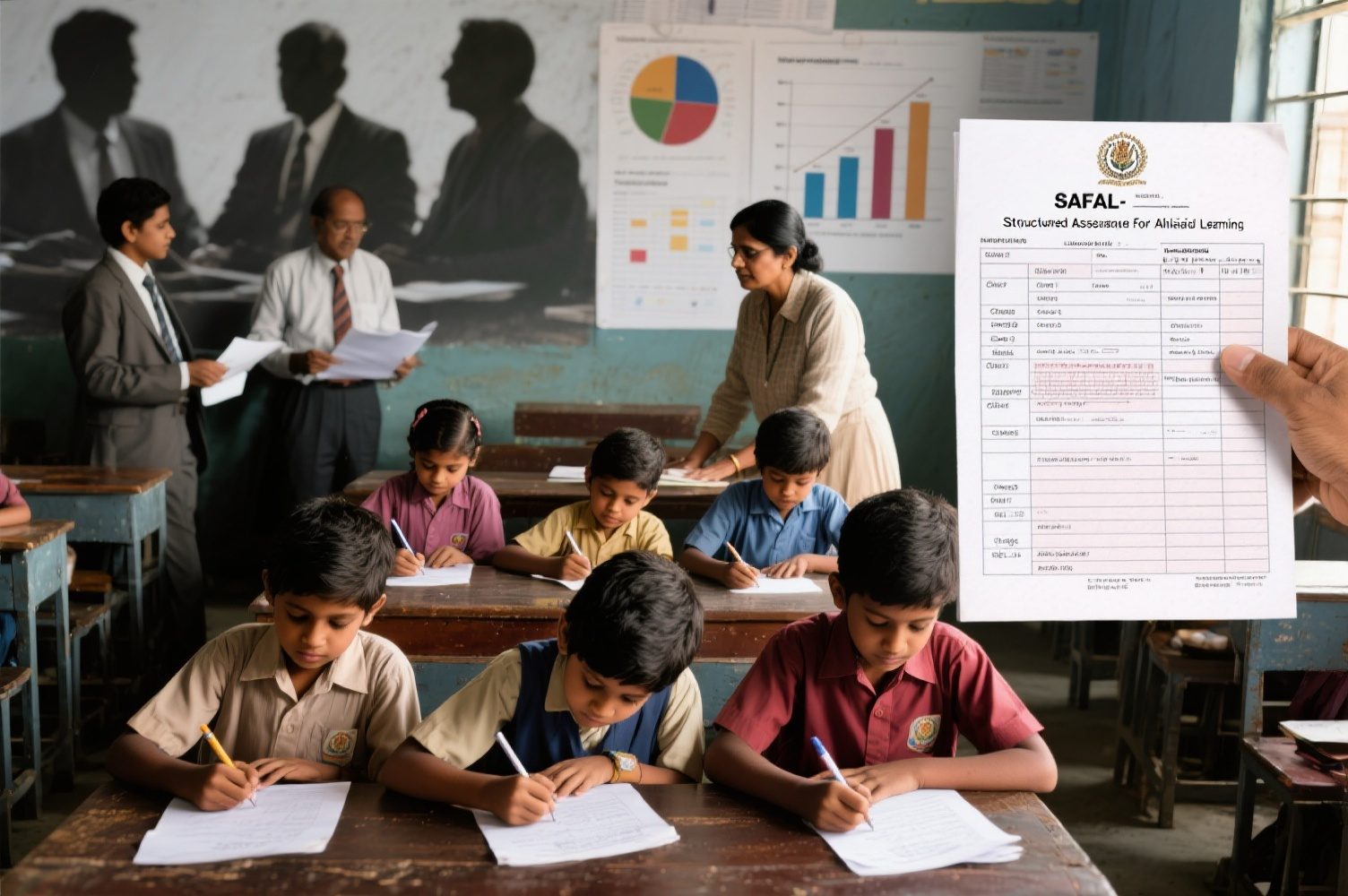- December 8, 2023
- by Educational Initiatives
- Blog
- 0 Comments
On the first anniversary of the National Education Policy (NEP), 2020, Prime Minister Narendra Modi announced the launch of the Structured Assessment for Analysing Learning (SAFAL) , an assessment for students of classes 3, 5 and 8. In line with the goals of the NEP, it is envisioned to be a census assessment, in which every child in these classes gets tested. It is an ambitious project, aiming to establish.
“A formal protocol to collect valid and reliable data to chart students’ performance on competencies at and below the grade level and monitor progress. It can report school-level performance on key competencies and proficiency levels, and be used to measure effectiveness of a system through systematic monitoring and reporting of learning levels.”
The Viability of Census Tests
Census assessments of this sort do provide some benefits. Their results can generate individualised report cards for every student which identify learning levels, misconceptions, areas of improvement, and remediation suggestions. Unbiased and aggregated student performance data that presents insights on current shortcomings can be used to build accountability among teachers, schools and education departments.
However, census assessments suffer from certain important drawbacks. Organising any census assessment is logistically complicated and requires significant resources to successfully administer. The best-known census exams are, of course, the 10th and 12th class board exams. As of 2019, the Central Board of Secondary Education reportedly spent INR 500 crore to conduct board examinations for classes 10 and 12. Census assessments for lower levels (such as classes 3, 5, and 8 as suggested by the NEP) would actually be more, not less, complicated. One, because enrolment is higher in lower classes. (As per Ministry of Education data, there were almost twice as many students in class 3 than in class 12.) Additionally, managing younger children is more complicated.
Of course, some may say that the census assessments for lower-class students are intended to be low-stakes, i.e. without direct implications for further education (unlike board exams). Practically, however, stakeholders see any census exam as a high-stakes assessment. System-wide assessments trigger anxiety, pressure and competition amongst students, parents, and teachers.
This is not a hypothetical consequence; a previous proposal by Maharashtra to conduct census assessments for class 4 students provoked a widespread backlash by parents and was rescinded. The pressure on teachers to show good student performance can cause them to artificially boost results, either through malpractice or marks inflation. Both render the assessment exercise futile. These examinations also cause stakeholders to ignore important learning and development outcomes not relevant to the test and may result in the mushrooming of private coaching for lower classes.
Sample Assessments for Systemic Improvement
The drawbacks of census assessments do not mean systemic evaluation should be forgone altogether. Sample assessments, wherein a scientifically devised representative subset of students and schools are assessed, are a viable alternative. Well-known sample assessments currently conducted in India include Pratham Education Foundation’s Annual Status of Education Report (ASER), and the National Assessment Survey (NAS) conducted by the National Council for Education Research and Training.
While they may not provide individualised feedback for each student (unlike census tests), sample assessments are a useful barometer of the education system. They can help identify and address issues with the system, which should be done on priority. After all, individualised student feedback amounts to little if the education system isn’t equipped to act on it.
Well-designed sample assessments can assess weaknesses at a granular level. They can identify learning trends among students from different geographic and socio-economic backgrounds, and map them against expected levels. Education departments and schools can use this data to improve pedagogy and assessment in a focused manner. Without this knowledge, any interventions are likely to be blunt and potentially ineffective, regardless of intention.
Sample assessments are also logistically much easier to conduct. Unlike census tests, they need not be simultaneous and can happen over weeks or months. Additionally, since they do not provide individual student feedback but only aggregated data to reflect systemic practices, they are positioned as a ‘study’ and do not unduly burden students, teachers and parents (and consequently provide a truer picture of learning levels). However, rigorous accountability structures must be established to ensure that all stakeholders do not consider these assessments a mere formality.
Effective sample assessments must be designed with certain principles in mind. Like any other specialised task, question and test-paper creation is an art and science based on expertise, practice and data. Assessment agencies, whether private or government-run, must work hard to develop these capabilities. Major international assessments like the Programme for International Student Assessment (PISA), for example, are created by one or more specialist agencies, and undergo thorough checks to verify their effectiveness. Question creators must have nuanced knowledge of student response patterns in examinations. Armed with relevant insights, they can create and modify questions to make assessments effective.
To accurately diagnose systemic issues, assessments must be designed keeping in mind certain principles:
- The should test key skills that students are expected to master, including skills from lower classes, as necessary.
- High-quality questions that require students to understand and apply conceptual knowledge are a must; questions that test only factual knowledge or rote-memorization skills make for futile exercises.
- Questions must test a range of difficulty levels to diagnose variations in within-class learning levels.
- They also must be designed to capture common misconceptions among students to facilitate targeted remediation at the systemic level.
No Option to Opt-Out
When testing a select few schools/students as a reflection of the system, test administrators should ensure that sample assessments be conducted instead of opt-in tests (where students and/or schools can choose to partake or not). Opt-in assessments are beneficial in certain circumstances. For example, schools or students may voluntarily undergo assessments to identify individualised learning levels, misconceptions or indeed, giftedness. Such examinations can also be a part of admissions procedures for higher-studies, as is the case with Standardised Assessment Tests (SATs) for US universities or the Joint Entrance Exam (JEE) for Indian engineering colleges. Here, they create a degree of standardisation amongst interested applicants from diverse educational backgrounds.
However, these are both situations that demand greater knowledge about individual students or schools. When reforming the education system, gaining insight into the system itself is of greater priority. For this, assessments must be scientifically designed and administered to capture a representative sample of the target population. Students and schools from all demographic backgrounds must be included in a manner proportional to their population within the country. If instead, they are allowed to opt in or out, only those schools or students confident of performing well will likely opt-in. This self-selection bias will generate inaccurate and artificially inflated assessment results, and be of little use when planning subsequent interventions.
Improving Education with Assessments
After weighing census, sample and opt-in assessments against each other, starting with well-designed sample assessments can create accountability and catalyse reform in the education system. These assessments need not only be conducted by the government; private organisations (such as Pratham with ASER or Educational Initiatives (EI) with its 2008 Student Learning Study) may conduct them as well.
Each additional assessment acts as a quality-control mechanism for others and can be used to examine different aspects of our system. For example, ASER tests basic reading and arithmetic abilities of students aged 5-16. Any new sample assessments could, for example,
focus exclusively on foundational learning, early childhood education outcomes, or higher-order thinking skills, depending on their target demographic. These would help develop a more holistic understanding of India’s education system and better identify areas that need improvement.
Sample assessments can have long-term, exponential benefits for the system in the same way census tests can, but at a fraction of the cost and complexity. Findings in ASER, for example, have been central to most analyses of and reform in India’s education over the last 15 years. Despite their evident utility and impact, no other such tools have been created. More well-designed and administered sample assessments can only strengthen our system, and should therefore be a priority, both for the government and civil-society organisations.



